

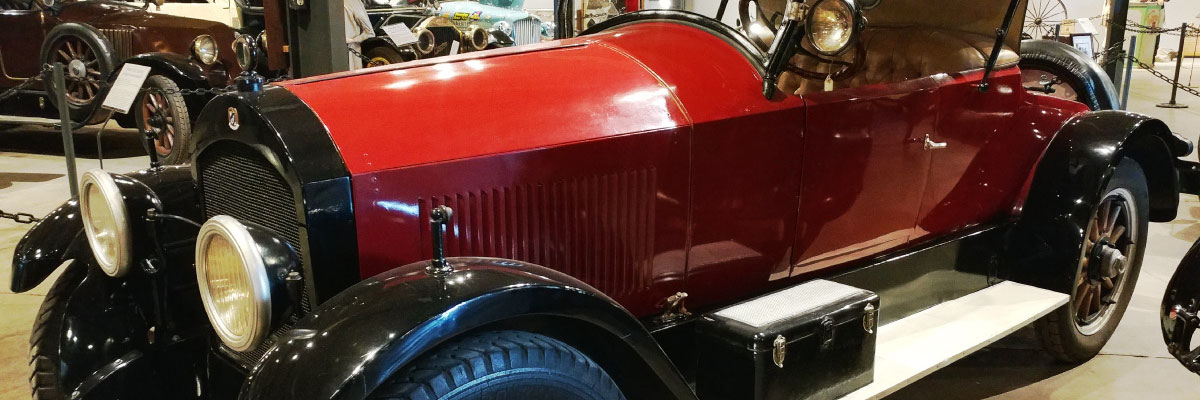

by AL FRANK
Big Boys---sometimes referred to as “Titans of the Wahsatch”, were the epitome of steam engineering skills and were built for pure economic reasons---the ability to pull more tonnage at more miles per hour. The steep climb east of Ogden, Utah, over the Wahsatch, presented a challenge to all of the Union Pacific equipment. Union Pacific, always looking for bigger and better pulling power, envisioned a locomotive the size of a Big Boy to do the pulling---and the Big Boy did.
The emphasis for more power to overcome the Wahsatch came under the administration of E.H.Harriman who had previously used motive power from various manufacturers using two and three helper engines as a standard practice. Under Harriman’s administration also came large steam power such as compound Mallets and later 4-10-2s, 4-12-2s, and finally in 1936, the famous articulated Challenger series 4-6-6-4s. With each new locomotive the railroad hoped to reduce or eliminate the need for helpers required for the sixty-five miles from Ogden to the Wahsatch which became known as the helper district.
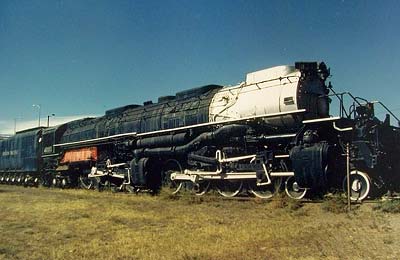
Within a short period of time the design was forwarded to the American Locomotive Company, (Alco), in Schenectady, N.Y., who incorporated further design and construction details. From start to finish the project consumed only about one year which included six months of design, fabrication, acquisition of parts, and six months to erect the completed locomotive. There have been stories told of how one of the machinist’s chalk marks on the boiler of the 4000 when it was being built led to its name of Big Boy. There had also been rumors, but no documentation, that a possible considered name for this huge locomotive was to be Wahsatch but the press appeal of the newspapers had its impact and the name Big Boy stuck. The usual procedure for a railroad in acquiring new equipment would be to order a small quantity, sometimes only one. The Union Pacific felt so confident that they placed an order for twenty at one time knowing they would perform as designed. Keeping in mind they cost $265,174 each, they made some important calculations on how many would be needed to handle all of the freight and fresh fruit block shipments between Ogden and Green River plus allowing for down time and maintenance in their shops at any given time.
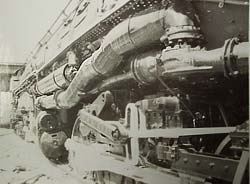
The first Big Boy, 4000, was turned over to the Delaware and Hudson and then the New York Central to Chicago. From there the Chicago and Northwestern carried the 4000 to Council Bluffs where a UP switcher made the short trip to the Omaha shops where it was officially accepted at 6 PM, September 5, 1941. It was then serviced completely, rods connected, fired up and run to the Omaha Union Station for a celebration. From there it was moved to the Council Bluffs terminal where it was serviced and then it began its trip west to Ogden, Utah. After its arrival in Ogden the big test was yet to come the next morning. How will it perform pulling a 3500 ton train up the Wahsatch? With Vice President Jabelmann in charge of the test, the first Big Boy took hold and belching smoke it surged up the grade causing the officials to be elated over the performance. In early 1941, before the first Big Boy was built, track clearances had been checked from Council Bluffs to Ogden, Utah, to accommodate the new “giant power” making some modifications necessary to the tracks including the rail weight and clearance distances between double tracks on curves. The modifications also included some revisions to the design of the locomotives such as reducing the widths of the running boards.
In 1943 Big Boys matched their strength, (horsepower), against a three unit diesel between Ogden and Evanston. Being steam locomotives are rated by a calculation determining “tractive effort” and not horsepower, the tests used a dynamometer car and the Big Boy easily equaled the diesel performance. The tests indicated the horsepower developed by the Big Boys averaged 5,937 horsepower. American Locomotive Company design statistics indicate the ability to develop 7,000 HP.
In 1944 five more Big Boys were ordered and added to the roster to be used between Ogden, Utah, and Cheyenne, Wyoming. Even though Big Boys were actually cleared to run on some trackage between Salt Lake City and Milford, Utah, Cache Junction, Pocatello, and McCammon, Idaho, Big Boys actually never operated on any of these routes except the one to Milford. A little known fact is that 4000’s were cleared for operation between Ogden and Los Angeles but no records indicate they ever made the trip and as a result they were not used for any regular scheduled service west of Ogden. East of Cheyenne there was also no regular scheduled service except for an occasional trip to Denver pulling troop trains and into Nebraska during the blizzard of 1949 and coal strike of 1950. The original intent of the Big Boy design was for the pulling of freight in the 35-45 mph range even though they were designed for a maximum of 80 mph. On occasion they were used for passenger service but passenger service was better served by the Challenger series. Also little known, or remembered, is the 4024 was selected in the summer of 1948 to be a UP ”representative” at the Chicago Railroad Fair. It was prepared for its role in Cheyenne shops and then traveled on UP and Chicago & Northwestern rails in dead freight to Chicago and returned after the Fair.


The 4005 on display at the Forney Museum of Transportation was donated to the Museum in June of 1970. It is quite complete and intact. The 4005 is the only one of the Big Boys converted to burn oil in 1946 as a test project for all 4000’s due to the threatened disruption of available coal supplies because of a coal strike.The test lasted through March, 1948. Because of the firebox design not allowing oil burning to develop sufficient heat to produce the required steam pressure it was returned to its original configuration using coal for the balance of its operating life.
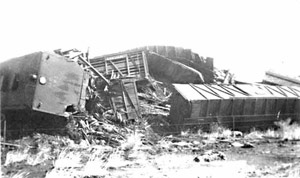
In 1953, the Big Boy 4005 was involved in an accident involving fatalities. It was repaired and returned to service leaving some of the scars of the accident on the left side. The 4005 is displayed indoors at the Forney Museum for its protection and year round viewing comfort of our visitors. The Big Boy’s cab is illuminated and contains many of the original valves, meters, and controls which are labeled for easy identification. The stairway to the cab platform between the locomotive and tender is always open, easily accessible, and safe for visitors of all ages. On special occasions, such as the yearly “Big Boy Day”, the cab is opened so visitors may enter and have a close-up view of the controls and the interior of the firebox, and, experience first hand what it was like when the engineer and fireman were seated at the controls looking down the track and operating what is considered the largest steam locomotive ever built.
All Big Boys, numbered 4000 to 4024, were officially retired by 1961-1962 with eight of the original 25 remaining on display at various locations from Pomona, CA to Scranton, PA. The 4005 was the last Big Boy to drift down Sherman Hill from Green River to Cheyenne where it underwent a cosmetic makeover by the UP before it was received by the Forney Museum of Transportation. This Big Boy had logged approximately one million miles before it became a museum exhibit.
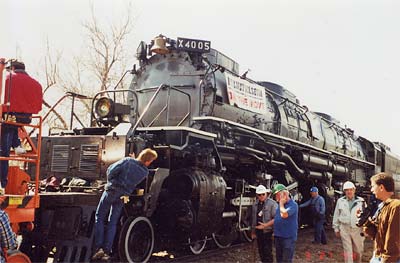
“To those who enjoyed the romance of the rails, the bark of a steam locomotive at work on the grade, Union Pacific’s Big Boy was a live giant of steam and steel, thundering out of the West over the rails of the Nation’s first transcontinental railroad.” As well as being impressive, even overwhelming to the sights and senses, they were extremely successful and no other steam engine could equal their performance.
Credits are given to the Colorado Railroad Museum Richardson Library Collection, Union Pacific Library Data Sheets, American Locomotive Company Data Sheets, and books by William Kratville---“Big Boy”, and “Motive Power of the Union Pacific” by Kratville and Ranks.
Big Boy Wreck
Moffat Modelers Railroad Group
They have been constructing and operating a 20’ x 100’ fixed layout model railroad system in 1:160 (N Scale) which models the former Denver and Rio Grande Western, now Union Pacific railroad line between Downtown Denver and the Moffat Tunnel, aptly named the Moffat Route.
Open every 2nd and 4th Saturday.
*Schedule is subject to change.
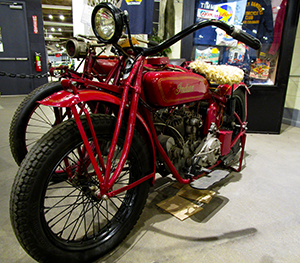
The Timme Motorcycle Collection
Come and see some incredible vintage Indian, Honda & other rare motorcycles! *Exhibits subject to change without notice*

Visit our Gallery
Make sure to visit our gallery. Our gallery features various die-cast models, art, and other artifacts related to transportation.